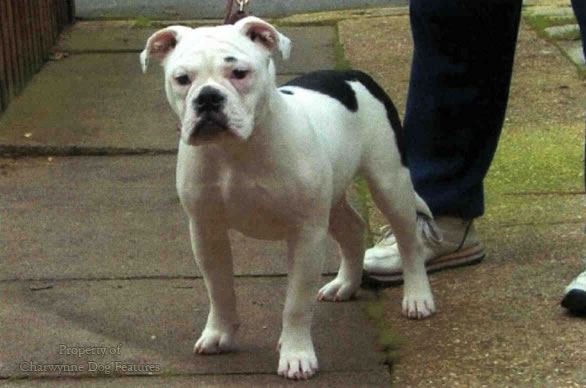487 Dorset Bulldogges
REVIVING THE REAL BULLDOG
by David Hancock

Those of us who prize dogs for what they can do rather than what they look like have long mourned the loss of our true Bulldog. From time to time Bulldog devotees have tried to reproduce the traditional type as opposed to the show ring specimen. Clifford Derwent, with his 'Regency Bulldog', produced some impressive specimens but couldn't get the temperament right. The late Ken Mollett, with his 'Victorian Bulldogs' did succeed and the society he formed lives on. But now the Dorset Bulldogge fanciers are succeeding too, producing active athletic dogs which live long healthy lives and look real characters.
Their club is 14 years old, their breeding programme is now 22 years old, and their first stud-book entered dog is now 14 years old. I do not know of a Kennel Club-registered Bulldog living to such an age. Their club has well over 350 members and conducts three well-attended shows a year, featuring quite admirable dogs. The Dorset Bulldogge breeders are seeking a dog standing around 20 inches at the shoulder, ranging from 60 to 90 lbs, stocky, well-muscled, with a muzzle long enough to permit good respiration and a torso which allows natural whelping. This is in contrast with the KC-registered Bulldogs, which give birth by caesarean and all too often have breathing difficulties. The KC has now had to amend the breed standard for the breed they recognise, to include the phrase 'Dogs showing respiratory distress highly undesirable.'
The Dorset Bulldogge Club now has representatives in America, Canada, Spain, Norway and Taiwan, with interest coming from kennels in Australia, Germany, Holland, France, Portugal, Greece and Malta too. The club members are maintaining two lines in the emergent breed: a straightforward 'bully' type and a lighter more agile 'performance' type. The terrier blood used in early breeding plans has restored activity to this style of dog, as well as removing health problems which affect Bulldogs with virtually no muzzle, hips too narrow to allow natural whelping, disproportionately large heads and an anatomy which only permits laboured movement. These healthier Dorset Bulldogges are a timely introduction. The UK may well sign up soon to European legislation banning the breeding of muzzleless dogs and perpetuating type irrespective of health issues. Our KC is anticipating this by rewording a number of breed standards; I do hope that both breeders and judges will react.
For a group of well-intentioned fanciers to come together as the Dorset Bulldogge ones have, and produce not only a healthier dog, able to live a long and active life, but one resembling the real bulldog of past centuries, is heart-warming. The show ring specimens at Crufts are miles away from the agile, athletic dogs once renowned all over the world as gutsy, determined, never-say-die exemplars of our national character. These Dorset Bulldogges really do look and act like bulldogs and are a major step forward in restoring the national breed to us, in the form we once prized. All power to them. May they and their dogs go from strength to strength. They certainly deserve the support and interest of every patriotic dog-lover.
